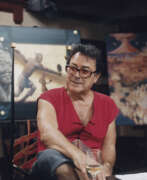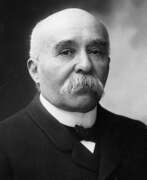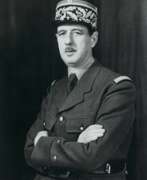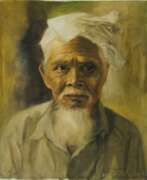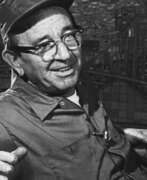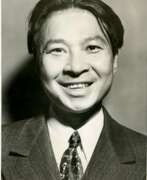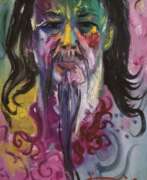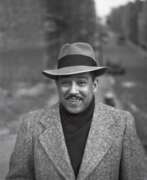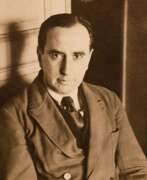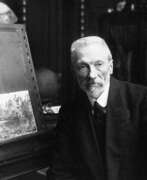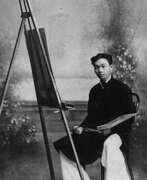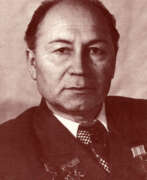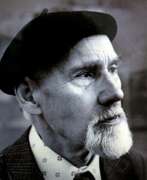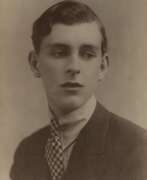Public figures
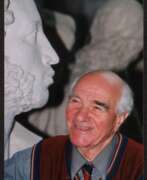

Mikhail Konstantinovich Anikushin (Russian: Михаил Константинович Аникушин) was a Soviet and Russian sculptor, celebrated for his monumental works that have left a lasting legacy in the art world. Born on September 19, 1917, in Moscow, Anikushin's sculptures are a testament to his profound skill and dedication to depicting historical and cultural figures with a dynamic expressiveness that brought them to life. His most notable works include monuments dedicated to Alexander Pushkin, found at the Pushkinskaya Station of the Saint Petersburg Metro and Arts Square in Saint Petersburg, as well as a monument to Vladimir Lenin at Moskovskaya Square in Saint Petersburg.
Anikushin's career was distinguished not only by his artistic achievements but also by the honors he received, reflecting the impact of his work on Russian culture. He was awarded the title of "Honored Artist of the RSFSR" in 1957, "People's Artist of the USSR" in 1963, and became a full member (academician) of the Russian Academy of Arts in 1962. His dedication to capturing the spirit and essence of his subjects, particularly Alexander Pushkin and Vladimir Lenin, showcases his innovative approach to sculpture, moving beyond traditional standards to depict his subjects in active, dynamic poses.
The Presidential Library collection dedicated to Anikushin commemorates the 100th anniversary of his birth, highlighting his significant contributions to Russian sculpture in the 20th century. Anikushin's works are integral to the aesthetic and cultural landscape of Leningrad (now Saint Petersburg), contributing to the city's historical and artistic identity. The collection also emphasizes his role in the community, including his public service and the enduring influence of his artistic vision on generations to come.
Collectors and experts in art and antiques recognize Mikhail Konstantinovich Anikushin not only for his technical prowess but also for his ability to imbue his sculptures with a sense of movement and emotional depth that resonates with viewers. His works remain landmarks, celebrated both in Russia and internationally, for their contribution to the cultural heritage.
For those interested in exploring the works and legacy of Mikhail Konstantinovich Anikushin further, signing up for updates can provide invaluable insights into new discoveries, exhibitions, and auction events related to this influential sculptor. This subscription is an opportunity to stay informed about the sales and exhibitions that continue to celebrate Anikushin's remarkable contribution to the world of sculpture.
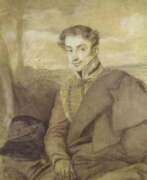

Alexander Ivanovich Dmitriev-Mamonov (Russian: Александр Иванович Дмитриев-Мамонов) was a Russian military commander and battle painter, known for his significant contributions both in the military and in the arts. Born on December 24, 1787, in Saint Petersburg, he was the son of Major-General Ivan Dmitriev-Mamonov. His early career saw him serving as an actuary at the Collegium of Foreign Affairs and later at the State Chancellery.
Dmitriev-Mamonov joined the People's Militia in 1812, rising to the rank of Lieutenant and participating in key battles such as Borodino and Krasnoi during the Napoleonic Wars. By 1823, he was promoted to Colonel and subsequently to Major-General in 1831, commanding various cavalry regiments. Apart from his military endeavors, Dmitriev-Mamonov was also an accomplished amateur artist. He co-founded the Imperial Society for the Encouragement of the Arts and established a drawing school in 1827. His battle sketches and watercolors are prominently displayed in Tsarskoye Selo.
In 1835, he transitioned to civil service, becoming a State Councillor at the Ministry of Internal Affairs. His notable awards include the Order of Saint Vladimir, Order of Saint Anna, and the Medal "For the Capture of Paris." Dmitriev-Mamonov's legacy is preserved through his artistic works and his contributions to Russian military history.
For more updates on auctions and sales related to Alexander Ivanovich Dmitriev-Mamonov's works, sign up for our newsletter to stay informed about new product sales and auction events.


Ilya Sergeyevich Glazunov (Russian: Илья́ Серге́евич Глазуно́в) was a distinguished Soviet and Russian artist, born on June 10, 1930, in Leningrad, and passing away on July 9, 2017, in Moscow. Glazunov was not just a painter; he was a visionary and an educator who founded the Russian Academy of Painting, Sculpture, and Architecture in Moscow, where he also served as rector until his death. Glazunov's artistry was deeply rooted in historical and religious themes, as seen in masterpieces like Russia the Eternal, The 20th Century Mystery, and The Ruining of the Temple on Easter Night, along with his celebrated illustrations for Fyodor Dostoyevsky's works.
Glazunov's contribution to Russian art and culture was immense. He was a full cavalier of the Order "For Merit to the Fatherland," among other honors, acknowledging his significant role in the national art scene and education. Notably, during the 1970s, Glazunov played a key role in saving parts of Moscow's historic center from destruction due to proposed restoration plans, showcasing his commitment not only to the arts but also to preserving Russia's cultural heritage.
Collectors and experts in art and antiques admire Glazunov for his unique blend of artistic brilliance and dedication to cultural preservation. His works, which are held in high esteem across the globe, are a testament to his skill, vision, and unwavering love for his homeland. For those intrigued by Glazunov's legacy and wishing to explore his works further, subscribing for updates on new sales and auction events related to Ilya Sergeyevich Glazunov is highly recommended. This subscription is an invaluable resource for staying informed about opportunities to own a piece of Russian art history.


Keith Allen Haring was an iconic American artist, recognized globally for his distinctive contributions to painting, sculpture, and art culture. Haring's work is celebrated for its vibrant, dynamic imagery and its profound social activism, which addressed critical themes such as AIDS awareness, racial inequality, and the empowerment of communities through art. His art transcends conventional galleries, marking its presence in public spaces, museums, and collections worldwide, thereby democratizing art access and engagement.
Haring's unique approach to art was characterized by bold lines, vivid colors, and animated figures, which not only attracted art collectors and experts but also resonated with a broader audience. His ability to blend art with activism, using public spaces as his canvas, was revolutionary. Works like the "Crack is Wack" mural and the untitled piece on the Berlin Wall stand testament to his commitment to societal issues, making him a pioneer in using art as a tool for social change.
Keith Haring's legacy continues through the Keith Haring Foundation, established by the artist in 1989 to support children's programs and organizations dedicated to raising AIDS awareness. The Foundation ensures that Haring's artistic and philanthropic vision persists, facilitating exhibitions and educational initiatives. For collectors and art experts keen on exploring Haring's influential body of work and its impact on contemporary art and culture, his creations offer profound insights into the intersection of art, social activism, and community engagement.
For those interested in staying informed about new product sales, auction events, and exhibitions related to Keith Allen Haring, signing up for updates is a straightforward way to remain connected with the ongoing celebration of his art and humanitarian legacy. This subscription ensures direct access to the latest on Haring's impactful contributions to the world of art and culture.
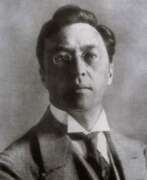

Wassily Wassilyevich Kandinsky (Russian: Василий Васильевич Кандинский) was a trailblazer in the art world, known for his pioneering role in the development of abstract art. Born in Moscow, Russia, in 1866, Kandinsky embarked on a journey that would take him from the study of law and economics to becoming one of the most influential artists of his time. His journey into the arts began at 30, a significant shift from a promising career in law to attending the Academy of Fine Arts in Munich. This decision marked the start of a profound exploration of color, form, and the spiritual in art.
Kandinsky's work is celebrated for its innovative use of color and abstract forms, with notable pieces such as "Composition VII" and "On White II" showcasing his ability to evoke emotional resonance through non-representational means. His art was not just about visual aesthetics but also aimed to touch the spiritual and emotional realms of the viewer. He often compared his method of painting to composing music, emphasizing the emotional power of abstract forms and colors. This philosophy was reflected in his theoretical writings, notably in "Concerning the Spiritual in Art," where he laid out his beliefs about the role of art and the artist in society.
Throughout his career, Kandinsky was involved with several avant-garde groups, including Der Blaue Reiter and Die Blaue Vier, collaborating with other influential artists of the time like Paul Klee and Alexej Jawlensky. After the Bauhaus school, where he taught, was closed by the Nazis, Kandinsky moved to France, where he spent the remainder of his life, continuing to evolve his style and contribute to the art world until his death in Neuilly-sur-Seine in 1944.
Kandinsky's legacy is not only in his artworks, which are held in esteemed collections worldwide, such as the Solomon R. Guggenheim Museum in New York, but also in his impact on the course of modern art. He opened up new possibilities for artists by demonstrating that art could venture beyond the representational and delve into the purely abstract, exploring the inner emotional and spiritual life through form and color.
For those captivated by Kandinsky's revolutionary approach to art and interested in the evolution of abstract expression, signing up for updates on new product sales and auction events related to Kandinsky's work is an excellent way to stay informed. This subscription service is tailored for collectors and art experts, ensuring you are the first to know about opportunities to acquire pieces by or related to this groundbreaking artist.
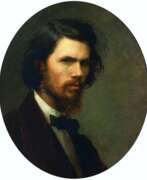

Ivan Nikolayevich Kramskoi (Russian: Иван Николаевич Крамской), a distinguished Russian painter and art critic, emerged as a pivotal figure in the Russian art scene during the latter half of the 19th century. Born into modest circumstances in 1837, Kramskoi's journey from a retoucher and watercolorist to a leading intellectual force in the art movement known as the Wanderers, or Peredvizhniki, underscores his dedication to art and its societal impact. His education at the St. Petersburg Academy of Arts was a turning point, leading to his active rebellion against academic art through the "Revolt of the Fourteen," which culminated in the formation of the Artel of Artists, a group advocating for realism and the moral duty of the artist.
Kramskoi's oeuvre is celebrated for its masterful portraits, which he paradoxically considered a burden yet excelled in, creating around 3,000 pieces that captured the essence of his subjects with unparalleled depth. His portraits of Russian writers, scientists, artists, and public figures are notable for their expressive simplicity and profound psychological insight, reflecting his democratic ideals and the belief in the artist's societal role. Among his well-known works are "Christ in the Desert" (1872), "Portrait of an Unknown Woman" (1883), and "Inconsolable Grief" (1884), all housed in the Tretyakov Gallery, showcasing his ability to blend portraiture with genre painting to explore complex emotions and moral-philosophical themes.
Despite his critical stance on portrait painting as mere means to support his family, Kramskoi's legacy is largely defined by these works, revealing the tensions between his artistic aspirations and the demands of livelihood. His leadership in the Association of Traveling Art Exhibitions (Peredvizhniki) significantly influenced Russian art, championing realism and accessibility of art to the public.
Kramskoi's personal life, marked by a marriage born out of a romantic and ideological alignment with the values of his time, and his untimely death at the age of 49 from an aortic aneurysm, add a poignant note to his story. His contributions to art and his critical perspectives on its role in society continue to be revered, making him an essential figure in the study of Russian realism and the broader art historical canon.
For collectors and experts in art and antiques, Kramskoi's works represent not only exceptional artistic achievements but also a window into the cultural and social dynamics of 19th-century Russia. His dedication to capturing the human spirit, whether in the guise of famous personalities or common folk, ensures his enduring relevance and appeal.
To stay updated on sales and auction events related to Ivan Nikolayevich Kramskoi's works, signing up for updates is a pragmatic step for enthusiasts keen on exploring the depths of Russian art and culture. This subscription is a gateway to engaging with the legacy of a painter who skillfully balanced personal conviction with public duty, leaving behind a rich trove of art that continues to inspire and captivate.
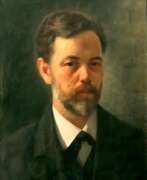

Andronik Grigorievich Lazarchuk (Russian: Андроник Григорьевич Лазарчук) was a Ukrainian and Soviet artist, born on January 15, 1870, in Ukhovetsk, Volhynian Governorate, and passed away on September 6, 1934, in Borzna, Chernihiv region. Known for his contributions to painting, teaching, and cultural activities, Lazarchuk's work primarily featured portraits, everyday scenes, and landscapes.
Lazarchuk began his artistic journey studying icon painting in Kovel and later in the Pochaev Lavra's painting workshop. From 1889 to 1897, he attended the Higher Art School at the Imperial Academy of Arts in St. Petersburg, where he studied under prominent artist Vladimir Makovsky. His artistic style was influenced by his early religious training, which is evident in his detailed and expressive portraits and landscapes.
One of his notable works, "Portrait of a Man," showcases his ability to capture human emotion and character. His other works include small-format paintings like "Reading a Letter" and "Family Group," which highlight his focus on everyday life and personal interactions. Lazarchuk also contributed to the decoration of Ukrainian churches, such as the Holy Trinity Church and the Cave Churches of Pochaev Lavra, and worked as an illustrator for magazines like "Native Land" and "Young Ukraine".
Collectors and art enthusiasts can explore Lazarchuk's legacy by signing up for updates on new product sales and auction events related to his works. This subscription will keep you informed about opportunities to acquire pieces by this influential artist.
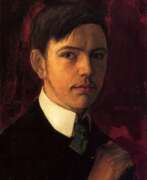

August Robert Ludwig Macke was a German Expressionist painter, celebrated for his vibrant use of color and innovative artistic techniques. Born in 1887 in Meschede, Germany, Macke played a pivotal role in the German Expressionist movement and was a founding member of Der Blaue Reiter (The Blue Rider) group. His work is characterized by a blend of Impressionism, Post-impressionism, and Fauvism, marked by an expressive use of color and form to convey emotions and moods rather than realistic depictions.
Macke's artistic journey was significantly influenced by his travels and encounters with other artists. His first trip to Paris in 1907 introduced him to Impressionism, and his subsequent time in Berlin and interactions with artists like Lovis Corinth further shaped his style. A key turning point in his career was his meeting with Robert Delaunay in Paris in 1912, which introduced him to chromatic Cubism, or Orphism, influencing his work thereafter, such as in "Shops Windows," which reflects Delaunay's impact combined with elements of Italian Futurism. Macke's travels to Tunisia in 1914 with Paul Klee and Louis Moilliet were instrumental in developing the luminist approach of his final period, producing masterpieces like "Türkisches Café."
Macke's contributions to art extend beyond his paintings; he was actively involved in the art community, establishing networks with other modernist artists across Europe. His collaboration with artists like Franz Marc and his role in organizing avant-garde art exhibitions helped promote modernist movements in Germany and beyond. Unfortunately, Macke's promising career was cut short when he was killed in action in 1914 during the First World War.
Macke's works are housed in prestigious museums and galleries worldwide, including the Sprengel Museum in Hanover, Museum Ludwig in Cologne, Städel Museum, and Museum Kunstpalast. His paintings, such as "Lady in a Green Jacket" and "Promenade," continue to be celebrated for their innovative approach to color and composition, leaving a lasting impact on the art world.
For art collectors and experts, Macke's oeuvre offers a fascinating insight into the evolution of early 20th-century European art, showcasing the intersections of cultural influences and artistic innovation. His works not only reflect the artistic movements of his time but also his personal explorations and responses to the world around him.
To stay informed about new product sales and auction events related to August Robert Ludwig Macke, consider signing up for updates. This subscription will provide exclusive access to the latest offerings and insights into the work of this influential Expressionist artist, ensuring enthusiasts and collectors don't miss out on valuable acquisitions.
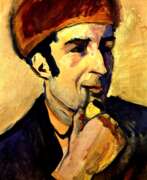

Franz Moritz Wilhelm Marc, a pivotal figure in German Expressionism, remains celebrated for his innovative contributions to 20th-century art. Born in Munich, Bavaria, within the German Empire on February 8, 1880, Marc's journey into the art world was profoundly influenced by his education at the Academy of Fine Arts in Munich. His distinct artistic vision is most famously encapsulated in works like "The Tower of Blue Horses", "Yellow Cow", and "Blue Horse I", each radiating with vibrant colors and emotional depth. Marc's affiliation with Der Blaue Reiter, a journal he co-founded, underscored his role in the German Expressionist movement, emphasizing the spiritual and symbolic significance of color in art.
Marc's oeuvre predominantly features animals, presented not merely as subjects but as embodiments of primal purity and emotional resonance. This choice of subject matter, combined with a stark, almost cubist portrayal, allowed Marc to explore themes of spirituality, masculinity (often symbolized by blue), and the tumultuous essence of life itself. His work "Fate of the Animals", which hangs in the Kunstmuseum Basel, exemplifies this thematic exploration, portraying a premonition of chaos and destruction that eerily anticipated the outbreak of World War I.
Tragically, Marc's promising career was cut short by his death at the Battle of Verdun on March 4, 1916, during World War I, where he served in the German Army. Despite his premature demise, Marc's legacy endures through his profound impact on modern art, as seen in his vibrant compositions that continue to captivate audiences in galleries and museums worldwide. His artworks, once labeled as "degenerate" by the Nazis, have transcended this vilification, achieving acclaim and fetching high sums at auction, with "Die Füchse (The Foxes)" reaching a record £42,654,500.
For collectors and experts in art and antiques, Marc's work represents not only a high point in German Expressionism but also a window into the artist's profound belief in the spiritual power of color and form. His legacy is a testament to the enduring allure and significance of early 20th-century modern art. To stay updated on sales and auction events related to Franz Marc's work, signing up for updates offers a direct link to the vibrant legacy of this remarkable artist.
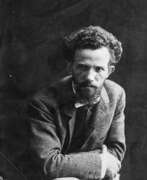

Oleksandr A. Murashko (Russian: Александр Александрович Мурашко) was a prominent artist of Russian and Ukrainian descent, renowned for his profound contributions to painting and art education. Born on August 26, 1875 in Kiev, Murashko's journey in art began at the prestigious St. Petersburg Academy of Arts, after which he honed his skills in Europe, including Paris and Munich. His determination led to the founding of the Kiev Art Academy, a milestone in the history of Ukrainian culture.
Murashko's art is characterized by a vivid depiction of light and shadow, a technique he honed during his acquaintance with Impressionism in Paris. His preference to paint intimate acquaintances rather than commissioned portraits added an individuality that resonated deeply with the art community. Despite his tragic death in 1919, Murashko's legacy lives on, notably through a special room in the National Art Museum of Ukraine and a monument on a Ukrainian bank coin in 2015, highlighting his cultural significance.
Characterized by a unique blend of realism and impressionism, his work reflected his deep connection to his roots and keen observation of light and life. The tragic end of his life, victimized by political upheaval, cut short a promising career, but his influence on Ukrainian art remains indelible.
For collectors and experts in art and antiques, Oleksandr A. Murashko's works represent not only aesthetic beauty, but also a rich historical narrative. His paintings are a testament to the resilience and creativity of an artist who has overcome the complexities of cultural identity through his art. To keep abreast of new sales and auction events featuring Murashko's work, we invite you to subscribe for updates. With this subscription, you will always be aware of all events related to this outstanding artist and will celebrate his enduring legacy in the art world.


Yehuda Pen (Russian: Юдель Моисеевич Пэн) was a Jewish-Belarusian artist-painter and teacher, recognized for his pivotal role in the Jewish Renaissance in Russian and Belarusian art at the start of the 20th century. Born on May 24, 1854, in Novoalexandrovsk (now Zarasai, Lithuania), Pen emerged as a significant figure, arguably paralleling Mark Antokolski's impact in sculpture. After moving to Vitebsk in 1891, Pen established the first Jewish art school in Belarus, offering training to many, including Marc Chagall, Ossip Zadkine, and El Lissitzky, who could not afford or gain admission to larger academies.
Pen's life was tragically cut short when he was murdered at his home in Vitebsk on the night of February 28/March 1, 1937, under unclear circumstances. His legacy, however, lives on through his works, primarily housed in Belarusian museums, including the Vitebsk Museum of Modern Art and the Belarusian National Arts Museum. Notable works include "Letter from America" (1903), "Old Tailor" (1910), and "Self-portrait with Muse and Death" (1925), showcasing his mastery in portraying everyday life and Jewish cultural themes.
Art collectors and enthusiasts keen on exploring the depths of Jewish art's evolution in the early 20th century would find Pen's work both intriguing and enriching. To stay updated on exhibitions and sales featuring Yehuda Pen's art, signing up for updates is highly recommended. This subscription will alert subscribers to new product sales and auction events related to Yehuda Pen, ensuring they don't miss out on owning a piece of history.
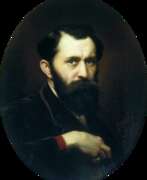

Vasily Grigorevich Perov (Russian: Василий Григорьевич Перов) was a celebrated Russian artist, renowned for his profound contributions to the world of painting. His body of work, characterized by its keen observation and poignant reflection on social issues, established him as a pivotal figure in the realm of 19th-century Russian culture. Perov's specialization in genre painting, alongside his ventures into portraiture and religious themes, showcased not only his versatility but also his deep empathy for the human condition.
Perov's artistry is distinguished by its vivid realism and emotional depth, qualities that marked a departure from the idealized narratives prevalent in the art of his time. His paintings often depicted the stark realities of everyday life, serving as a voice for the marginalized and overlooked sectors of society. This commitment to realism, combined with a masterful command of light and shadow, imbued his works with a powerful sense of immediacy and relevance.
Among his most notable works are "The Last Tavern at the City Gates," "The Arrival of a Governess in a Merchant's House," and "Troika. Apprentices Fetch Water." These paintings, along with others, can be found in prestigious museums and galleries, reflecting Perov's enduring legacy in the pantheon of Russian art. His ability to capture the essence of his subjects with both compassion and critical insight has left an indelible mark on the culture of art and painting.
For collectors and experts in art and antiques, the exploration of Vasily Perov's oeuvre offers a unique window into the socio-cultural landscape of 19th-century Russia. His works not only provide aesthetic pleasure but also invite reflection on the universal themes of human dignity, injustice, and the complexity of social dynamics. To stay informed about new product sales and auction events related to Vasily Grigorevich Perov, sign up for updates. This subscription is a gateway to the rich history and continuing relevance of Perov's artistry, offering exclusive insights into opportunities to own a piece of this illustrious legacy.
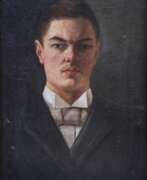

Kuzma Sergeyevich Petrov-Vodkin (Russian: Кузьма Сергеевич Петров-Водкин), a Russian painter, synthesized various traditions of global art, crafting a unique and deeply personal visual language. Born in 1878 in Khvalynsk, Saratov oblast, Russian Empire, Petrov-Vodkin is celebrated for his innovative approach to perspective, color, and composition, which positioned him as a pivotal figure in the art world of his time. He passed away in 1939 in Leningrad, now known as St. Petersburg, Russia.
Petrov-Vodkin's education in the arts took him from the Baron Stieglits School in Saint Petersburg to the Moscow School of Painting, Sculpture, and Architecture, where he was mentored by notable artists such as Valentin Serov. His studies abroad, including in Munich under Anton Ažbe, further enriched his artistic development. Notably, his marriage to Maria Jovanovic in Paris in 1906 marked a significant personal chapter, providing him with a lifelong companion and collaborator.
His work is distinguished by the use of "spherical perspective," a technique that distorts the drawing to emphasize the globe's curvature, making the viewer feel simultaneously distant and intimately close to the subject. This method, influenced by Byzantine iconography's inverted perspective, is evident in works like "Death of a Commissar" and "In the Line of Fire." Petrov-Vodkin's palette darkened over time, and his subjects diversified to include still life and portraiture, reflecting a broader exploration of theme and form. Despite facing health challenges, including pulmonary tuberculosis which limited his painting in later years, he remained prolific in other creative avenues, including literature, where his semi-autobiographical works are held in high regard.
His legacy is enshrined in the Russian Museum in St. Petersburg, which houses the largest collection of his works and dedicates a room to his art in their permanent exhibition. Additionally, a memorial museum in his hometown of Khvalynsk pays tribute to his contributions to Russian and Soviet art.
For collectors and art and antiques experts intrigued by Petrov-Vodkin's profound impact on Russian art, signing up for updates can ensure access to the latest sales and auction events related to his oeuvre. This subscription is a gateway to exploring the depth and breadth of Petrov-Vodkin's artistic achievements and ensuring enthusiasts are well-informed of opportunities to engage with his work.
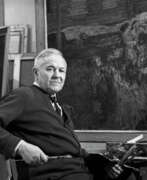

Arkady Alexandrovich Plastov (Russian: Аркадий Александрович Пластов), a luminary of Soviet art, was a Russian painter whose oeuvre is a testament to the simplicity and beauty of peasant life, making him a key figure in the realm of Soviet realism. His legacy is celebrated across Russia, with his works featured in prestigious institutions such as the State Tretyakov Gallery, Smolensk State Museum-Reserve, and the State Russian Museum in St. Petersburg, among others. Plastov's unique approach to art did not confine itself within the strict boundaries of socialist realism; instead, it traversed the depiction of peasant daily life and the intrinsic harmony between humans and nature.
Born into a family with deep roots in icon painting, Plastov's journey in art commenced in Prislonikha, Ulyanovsk province, where the landscapes and people of his hometown became the central theme of his work. Despite the hardships of a fire in 1931 that destroyed much of his early work, Plastov's resilience led him to create masterpieces that resonated with the Soviet populace. His dedication to portraying the truth of peasant life, through the lens of genuine admiration and respect for its beauty, earned him accolades such as the Stalin Prize, Lenin Prize, and the title of People's Artist of the USSR.
Plastov's paintings like "Haymaking," "Harvest," "First Snow," and "Spring" are vivid narrations of rural life, blending the everyday with the idyllic, thereby encapsulating the essence of Russian culture and its landscape. His works serve not only as historical records but also as celebrations of the human spirit and its connection to the land.
For collectors and experts in art and antiques, Plastov's paintings offer a glimpse into the soul of Soviet Russia, capturing the unadulterated beauty of its countryside and the resilience of its people. His art is a bridge between the past and present, reminding us of the enduring spirit of humanity against the backdrop of history.
To stay updated on exhibitions and auctions featuring Arkady Alexandrovich Plastov's work, sign up for updates. This subscription ensures you'll be the first to know about new sales and events related to this illustrious artist, keeping you connected to the heart of Soviet realism and Russian art tradition.
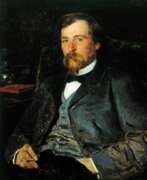

Illarion Mikhailovich Pryanishnikov (Russian: Илларио́н Миха́йлович Пря́нишников) was a distinguished Russian artist, celebrated for his contributions to painting and his role in the Peredvizhniki movement, a group dedicated to portraying real-life subjects through art. Pryanishnikov's work is characterized by its intricate detail, vibrant storytelling, and dedication to depicting the nuances of Russian life and landscapes. His ability to weave narrative, emotion, and cultural critique into his pieces has solidified his status as a pivotal figure in the realm of Russian art.
Pryanishnikov's artistry extends beyond his technical skill, offering a window into the cultural and societal dynamics of 19th-century Russia. His works, such as "Jokers. Gostiny Dvor in Moscow," showcase not only his mastery of form and color but also his keen observation of social interactions and historical context. These pieces are celebrated for their historical accuracy and emotional depth, making them invaluable to both art enthusiasts and historians alike. Pryanishnikov's dedication to realism and social commentary has made his paintings a cornerstone in the study of Russian culture and art history.
For collectors and experts in art and antiques, Pryanishnikov's works represent not just aesthetic beauty but also a profound investment in the rich tapestry of Russian heritage. His paintings, housed in prestigious museums and galleries across Russia, continue to inspire and captivate audiences with their timeless relevance and artistic merit. If you are passionate about the intersection of culture, art, and history, subscribing for updates on new product sales and auction events related to Illarion Mikhailovich Pryanishnikov is an invaluable opportunity. This subscription ensures that you stay informed about the chance to own a piece of Russian art history, directly connecting you to the legacy of one of Russia's most esteemed artists.
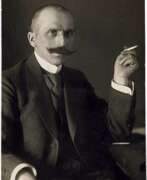

Vilhelms Kārlis Purvītis was a Latvian landscape painter and educator, celebrated for his profound influence on Latvian art and culture. Born in 1872 in the Kreis Riga area of the Governorate of Livonia, Purvītis is renowned for his mastery in capturing the neo-romantic atmosphere of Latvian nature through his paintings. He studied at the Imperial Academy of Arts in Saint Petersburg under Arkhip Kuindzhi, graduating with the Grand Gold Medal in 1897. His works, such as "Winter" (1910) and "Spring Waters (Maestoso)" (1911), showcase his evolution from Realism to Impressionism, influenced by European masters and movements like Art Nouveau.
Purvītis's contribution to Latvian art extends beyond his paintings. He founded the Latvian Academy of Art and served as its first rector from 1919 to 1934, shaping a generation of Latvian artists. His leadership roles at the Art Academy of Latvia and the Latvian National Museum of Art were pivotal in promoting Latvian art internationally, especially during the Republic of Latvia period. Despite personal losses, including the destruction of his house and many works during WWII, Purvītis's legacy endures through his influential teaching and the Purvītis Prize, established to recognize contemporary achievements in visual arts in Latvia.
For collectors and experts in art and antiques, Vilhelms Kārlis Purvītis's work represents not only a high point in Latvian landscape painting but also an embodiment of the country's rich cultural heritage. To stay updated on new discoveries, sales, and auction events related to Purvītis's work, signing up for updates is highly recommended. This ensures that enthusiasts and collectors alike are always informed about opportunities to engage with the legacy of this remarkable Latvian artist.
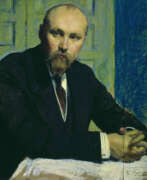

Nikolai Konstantinovich Roerich (Russian: Никола́й Константи́нович Ре́рих) was a distinguished Russian artist, writer, archaeologist, and philosopher, renowned for his profound contributions to culture and art. His multifaceted career spanned various disciplines, but it was his exceptional talent in painting that immortalized his name among the greats. Roerich's art is celebrated for its mystical and symbolic themes, often drawing inspiration from Russian folklore, religion, and his own spiritual quests. His dedication to cultural preservation and peace through art led to the establishment of the Roerich Pact, a treaty advocating for the protection of cultural heritage.
Roerich's paintings are characterized by vibrant colors and intricate details, capturing the ethereal beauty of landscapes and mythical scenes. His works, such as "Madonna Laboris" and the series "Sancta," are revered for their spiritual depth and artistic excellence. These masterpieces can be found in prestigious museums and galleries worldwide, serving as testaments to Roerich's enduring legacy in the art world. His commitment to integrating spiritual and cultural dimensions in his art has made him a seminal figure for collectors and experts in art and antiques.
Roerich's influence extends beyond his paintings; his philosophical writings and cultural initiatives have also left a significant mark on the fields of art and heritage preservation. As enthusiasts of art and antiquities continue to explore Roerich's rich legacy, there is a growing appreciation for his vision of unity and harmony through cultural expression. For those captivated by Roerich's remarkable life and works, signing up for updates is an invaluable opportunity to stay informed about new product sales and auction events dedicated to his art. This subscription is a gateway to exclusive insights and offerings that celebrate the legacy of Nikolai Konstantinovich Roerich, ensuring enthusiasts remain connected to the evolving exploration of his profound contributions.
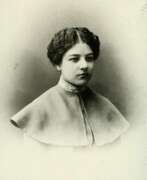

Olga Vladimirovna Rozanova (Russian: Ольга Владимировна Розанова), a Russian avant-garde artist, played a pivotal role in shaping the movements of Suprematism, Neo-Primitivism, and Cubo-Futurism. Born into provincial aristocracy, Rozanova's journey into the Moscow avant-garde scene marked the beginning of her innovative exploration in art, melding the theoretical vigor of Futurism with the aesthetic complexities of Cubism. Her work is celebrated for its pioneering use of color and abstract composition, setting a precedent for the Abstract Expressionists who would follow decades later. Rozanova's engagement with the avant-garde group Supremus, led by Kazimir Malevich, and her contributions to the 0,10 Exhibition illustrate her commitment to advancing the boundaries of visual art. Her theoretical writings, particularly "The Bases of the New Creation and the Reasons Why it is Misunderstood," highlight her intellectual depth and her belief in art's capacity to reflect and transcend the material world.
Rozanova's art transcends traditional boundaries, incorporating text and abstraction in a way that challenged and redefined the role of language and image in art. Her collaboration on the book "Zaumnaia Gniga" exemplifies her innovative approach to combining visual and verbal elements, pushing the envelope of how art communicates and interacts with the viewer. This blend of printmaking and collage underscores her vision of art as a multifaceted, deeply engaging experience.
Despite her untimely death at the age of 32 due to diphtheria, Rozanova's legacy endures through her influential works and theoretical contributions. Her masterpieces, including "Metronome" and the "Playing Cards" series, are celebrated for their inventive approach to Cubo-Futurism and abstract art. These works, housed in prestigious institutions like the State Tretyakov Gallery and the State Russian Museum, continue to inspire and challenge perceptions of art and its potential to convey complex, abstract ideas.
For collectors and experts in art and antiques, Rozanova's work offers a profound insight into the evolution of modern art and its foundational theories. Her life's work, characterized by a bold exploration of color and form, serves as a testament to her innovative spirit and her lasting impact on the art world. To stay updated on new discoveries and auction events related to Olga Vladimirovna Rozanova, signing up for updates is a step towards deepening one's appreciation and understanding of her contributions to avant-garde art.
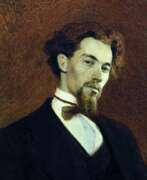

Konstantin Apollonovich Savitsky (Russian: Константи́н Аполло́нович Сави́цкий), a distinguished Russian realist painter, carved a unique niche for himself in the annals of art with his profound depictions of the common people's lives, focusing on their struggles and aspirations. Born on May 25, 1844, in Taganrog, Savitsky's early life was marked by personal tragedy and a deep commitment to his craft, which eventually led him to the Imperial Academy of Arts in Saint Petersburg. His talent was evident from his early days, as he garnered several awards, including a gold medal for his painting "Cain and Abel" in 1871, underscoring his exceptional skill and dedication to art.
Savitsky's association with the Peredvizhniki, a cooperative of Russian realist artists who eschewed the academic restrictions of the time, significantly influenced his career trajectory. His works, such as "Repairing the Railroad," highlight the lives of the working class, making a significant impact by bringing the hardships and dignity of ordinary people to the forefront of Russian art. This painting, along with others like "To the War" and "Morning in a Pine Forest" (initially co-credited with Ivan Shishkin), showcase his ability to convey complex social themes through art.
Beyond his contributions to painting, Savitsky's role as the director of the Penza Art School was pivotal in shaping the future of many young artists, emphasizing his commitment not only to art but also to education. His work, characterized by a nuanced understanding of light, composition, and the human condition, remains influential. His paintings are housed in various galleries, including the Tretyakov Gallery and the Penza Regional Picture Gallery named after him, ensuring his legacy endures.
For collectors and art and antiques experts, Savitsky's oeuvre offers a rich tapestry of Russian life and culture, woven with the threads of realism and empathy. His dedication to portraying the essence of peasant life and his innovative approach to art education mark him as a pivotal figure in the development of Russian art.
To stay updated on events, sales, and auctions related to Konstantin Apollonovich Savitsky's work, signing up for updates can provide exclusive access to the latest information and opportunities to acquire pieces by this seminal artist. This subscription ensures that enthusiasts and collectors are always informed about the most relevant and significant developments in the realm of Savitsky's art.
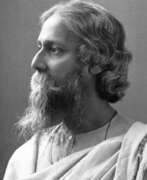

Rabindranath Tagore was a South Asian Bengali polymath who worked as a poet, writer, playwright, composer, philosopher, social reformer and painter. He reshaped Bengali literature and music as well as Indian art with Contextual Modernism in the late 19th and early 20th centuries. Author of the "profoundly sensitive, fresh and beautiful" poetry of Gitanjali, he became in 1913 the first non-European and the first lyricist to win the Nobel Prize in Literature. Tagore's poetic songs were viewed as spiritual and mercurial; however, his "elegant prose and magical poetry" remain largely unknown outside Bengal. He was a fellow of the Royal Asiatic Society. Referred to as "the Bard of Bengal", Tagore was known by sobriquets: Gurudev, Kobiguru, Biswakobi.
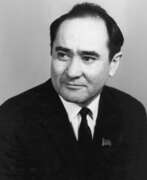

Mukhamedkhanafia Telzhanov (Russian: Мухамедханафия Тимирбулатович Тельжанов) was a distinguished Soviet and Kazakh artist, renowned for his expansive body of work that includes monumental paintings on revolutionary and military themes, genre pictures depicting the life of the Kazakh people, triptychs, landscapes, and portraits. Born on May 1, 1927, in what was then the Soviet Union, Telzhanov's artistic journey spanned across the mid to late 20th century, during which he made significant contributions to the world of art, embodying the spirit and culture of Kazakhstan through his creations.
Telzhanov's education and career were marked by notable achievements, including his studies in Saint Petersburg and Almaty, followed by his completion of studies at the prestigious Leningrad Institute of Painting, Sculpture, and Architecture named after I.E. Repin. His works, such as "Amangeldy Imanov" (1953), "The First Time" (1954), "Change", "Zhamal", "Mama Amina", and "Sounds of Dombra" (1955), among others, reflect his deep connection to his homeland and its people. Telzhanov's dedication to portraying the beauty, culture, and struggles of the Kazakh people earned him recognition as a People's Artist of the USSR and a corresponding member of the USSR Academy of Arts.
Beyond his artistic contributions, Telzhanov played a significant role in the educational realm, impacting the next generation of artists through his teaching positions at various institutions, including the Almaty Art and Theatre School, and later, the Kazakhstan State Art Gallery (now known as the A. Kasteev State Museum of Arts). His tenure as a professor and his leadership roles within the artistic community underscored his commitment to nurturing and advancing the arts within Kazakhstan.
Telzhanov's legacy is celebrated not only through his artworks but also through his contributions to the cultural and educational landscape of Kazakhstan. His works, characterized by their emotional depth and technical skill, continue to inspire art lovers, collectors, and students of art history, reflecting the enduring significance of his contributions to the cultural heritage of Kazakhstan.
For collectors and experts in art and antiques, the work of Mukhamedkhanafia Telzhanov represents a unique intersection of historical significance and artistic mastery. We invite you to sign up for updates related to new product sales and auction events featuring Telzhanov's work, ensuring you stay informed about opportunities to own a piece of this remarkable artist's legacy.


Nikolai Vasilyevich Tomsky (Russian: Никола́й Васи́льевич То́мский) was a distinguished Soviet sculptor, born in 1900 in the village of Staro Ramushevo, Novgorod province, into a family of a blacksmith. He became known for his monumental works that played a significant role in the artistry of the Socialist Realism era. Tomsky's educational journey in art commenced in Leningrad, where he graduated from the Arts and Crafts College in 1927. His rise to prominence began with his acclaimed memorial to Sergey Kirov, earning him the Stalin Prize in 1941. His work extended to designing Lenin's sarcophagus, creating Stalin's bust, and sculpting numerous statues of Lenin across the Soviet Union, including the notable red-granite Lenin in East Berlin.
Throughout his career, Tomsky received numerous accolades, including the title of Hero of Socialist Labor in 1970, multiple Orders of Lenin, and the Lenin Prize in 1972 for his granite monument of V.I. Lenin in Berlin. He was a laureate of the Stalin Prizes multiple times, received the USSR State Prize in 1979, and the State Prize of the RSFSR named after I.E. Repin in 1975 for his monument to M.I. Kutuzov in Moscow. His contributions to Soviet art were not only recognized in the USSR but also in the GDR, where he received the Order of Karl Marx.
Tomsky's works are celebrated for their ideological significance and artistic value, representing the Socialist Realism style's epitome. His sculptures, which include memorials to prominent Soviet figures and heroic compositions, are part of the cultural heritage of the Soviet era. For art collectors and experts in the field, Tomsky's creations offer a fascinating insight into the period's artistic and political landscape.
For those interested in the works and life of Nikolai Vasilyevich Tomsky, staying informed about new findings, sales, and auction events is essential. Signing up for updates can provide exclusive access to the latest information and opportunities to acquire pieces associated with this pivotal artist.
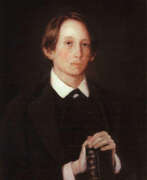

Apollinariy Mikhailovich Vasnetsov (Russian: Аполлина́рий Миха́йлович Васнецо́в) was a distinguished Russian painter and architect, celebrated for his pivotal role in bridging the realms of historical and landscape painting with a unique artistic vision. Born into a family with a deep artistic lineage, Vasnetsov's work was heavily influenced by Russian culture, history, and the natural landscape, which he depicted with a meticulous attention to detail and a vivid imagination. His specialization in creating historically accurate and vividly imagined views of ancient Russia set him apart from his contemporaries and solidified his status as a key figure in the Russian art world.
Vasnetsov's oeuvre is notable for its dedication to showcasing the beauty and complexity of Russia's past. His paintings often feature medieval and ancient Russian cities, imbuing them with a sense of romanticism and nostalgia. Among his most renowned works are his breathtaking views of the old Moscow, which are celebrated for their historical accuracy and atmospheric depth. These pieces not only offer a window into the past but also reflect Vasnetsov's profound love and understanding of Russian history. His works are housed in prestigious museums and galleries across Russia, serving as a testament to his lasting impact on the art world.
For collectors and experts in art and antiques, Vasnetsov's work represents a unique investment in Russian culture and heritage. His ability to weave together historical accuracy with artistic beauty makes his paintings highly sought after. We invite enthusiasts and collectors to stay informed on new discoveries, product sales, and auction events related to Apollinariy Mikhailovich Vasnetsov's work by signing up for updates. This subscription is your gateway to the latest offerings and opportunities to add a piece of Russian history and culture to your collection.
